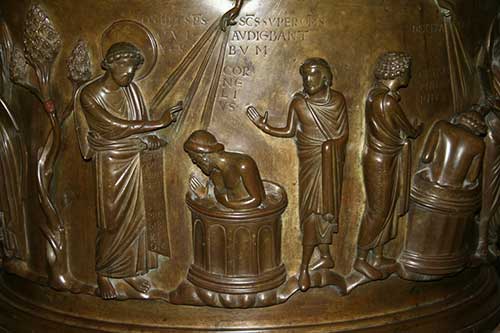
We can obviously forget to (re)present what, to us, may be obvious. In churches where there is no following of the traditional journey for adults to be baptised at the Easter Vigil, Lent can cease to be the baptised People of God “piggybacking” on that catechumenal journey, renewing and deepening, thereby, our own life in Christ – catechumens being those being instructed and formed in the final run up to their baptism.
Our (Lenten) liturgical life can, then, degenerate to just being one thing after another – rather than a coherent journey beginning by mirroring the baptismal oil cross in ash on Ash Wednesday, and concluding by renewing our baptism feet first on Maundy Thursday….
In the Early Church, those to be baptised at the Easter Vigil participated in a rite in which they were chosen (elected), followed by rites during Lent, called scrutinies, as they were instructed and formed in the Lord’s Prayer and the Creed, and prayed for by the Christian community. Many churches, deeply rooted in our Christian tradition, continue this today – adding adults to their number in our post-Constantinian context.
Dr Ian Paul reminded us of our forgetfulness that, in discussions in my circles (online and offline – eg here and here), prompted me to write this post. He asked:
Lectionary preaching friends: What is the reason for taking four encounters between Jesus and individuals in John for Lent, rather than reading from the lectionary gospel (as we did last year)? Thanks from an ignorant evangelical.
With the restoration, after Vatican II, of the adult catechumenal process and the Sunday scrutinies, Cycle A for these Lenten Sundays drew from the readings formerly used on the scrutinial Sundays of Lent. They present a fertile catechesis on the paschal mystery. This cycle may be used every year in churches where there are catechumens – and in fact, even in those that do not prepare adults for baptism. As a result, Cycle A, this year, presents the richest journey for Lent.
At least from the early fifth century, the temptation in the desert and the transfiguration (both from Matthew’s Gospel) were the Gospel readings of the first two Sundays in Lent. Then, Sunday by Sunday, we focus on the catechumenal journey: the Samaritan woman (Jn 4:5-42), the cure of the one born blind (Jn 9:1-41), the raising of Lazarus (Jn 11:1-45).
My rites for the catechumenal process may be found here and here.
Lent is marked by two themes, the baptismal and the penitential. By recalling or preparing for baptism and by repentance, this season disposes the faithful, as they more diligently listen to the word of God and devote themselves to prayer, to celebrate the paschal mystery. The baptismal and penitential aspects of Lent are to be given greater prominence in both the liturgy and liturgical catechesis.
Sacrosanctum Concilium – Constitution on the Sacred Liturgy 109


